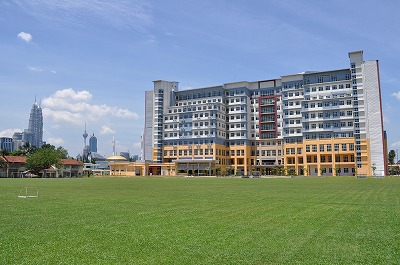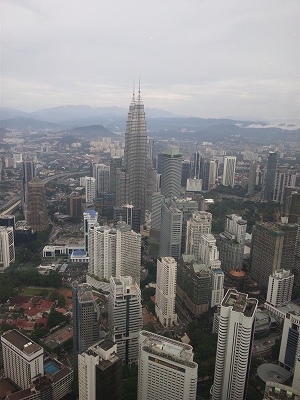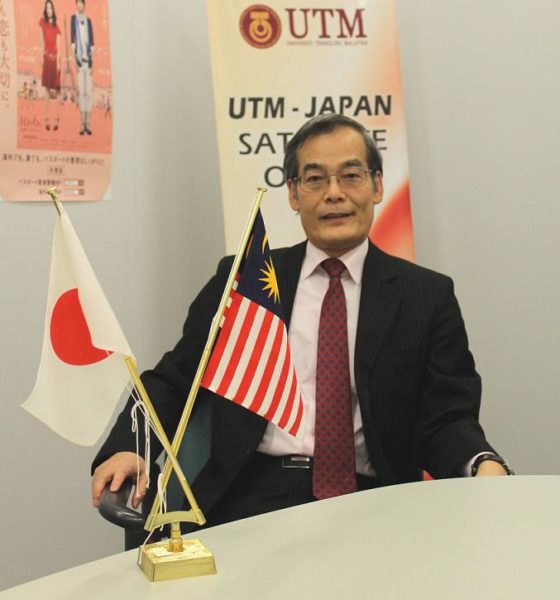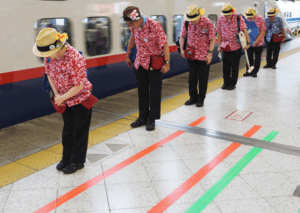Japan-Malaysia Relationships: What Comes After the Look East Policy? Japan and Malaysia from Vertical Relations to an Equal Partnership
CONTENTS
Look East Policy Still Alive
By Ryoji Shimada
Mahathir bin Mohamad, Malaysia’s former Prime Minister, began to espouse his country’s “Look East Policy” 30 years ago. That policy called for learning from countries in the East, especially Japan. Since then, however, the region and the world at large have undergone numerous changes, particularly in the wake of the Asian financial crisis in 1997 and the “Lehman Shock” a decade later. Furthermore, while Japan’s growth and influence have dwindled, the economies of other developing nations have surged and China now stands out as the world’s second biggest after the US. This raises the question: Is there anything still to be learned from Japan? The answer is “yes,” and Malaysia’s policy continues. Malaysian students are still coming to Japan on government scholarships, for example. But the program has now reached a turning point. Its focus has shifted more toward high valued-added industrialization, where Japan in many fields still boasts world-class technology and know-how. The newly established Malaysia-Japan International Institute of Technology (MJIIT) in Kuala Lumpur, Malaysia is a good example of how the policy has advanced to a new phase.
“Malaysia is already a developed country. So our aid policy pinpoints areas where Japan’s knowledge and expertise is utilized. Among them is higher education,” explains Nozomi Iwama, Director of South Asia and Pacific Department at JICA (Japan International Cooperation Agency), as the logic behind its policy in setting up MJIIT. “Through raising the level of the country’s standard of education, we’re helping to develop from a labor-intensive economy to high value-added industrialization.” MJIIT incorporates a variety of Japanese elements. Not only are some of the professors Japanese, but Japanese teaching methods have been adopted. As stated in its introductory brochure, “The unique Sempai-Kohai relationship or mentor-mentee concept is emphasized from the moment the students step into MJIIT until they graduate. And the implementation of the Koza laboratory system which promotes strong collaborative work by senior and junior researchers as well as continuous guidance from the professors in R&D projects strengthens the concept.”

The brochure also raises some other Japanese characteristics such as 5S and Kaizen. “5S” derives the Japanese words: Seiri, Seiton, Seiso, Seiketsu and Shitsuke, commonly referred to in English as sorting, straightening, systematic cleaning, standardizing, and sustaining. Kaizen is Japanese word for “improvement,” or “change for the better,” and refers to philosophy or practices that focus upon continuous improvement of processes, especially in manufacturing and engineering. MJIIT tries to incorporate these concepts into learning to develop such Japanese mindsets as teamwork, mutual responsibility and resilience.
MJIIT was established in September, 2011 as a new faculty at Kuala Lumpur Campus of UTM (Universiti Teknologi Malaysia), a top-level state-run engineering and technological university which has main campus in Johor Bahru. The JICA provided about 30% of its financial support through ODA Loan, about $83 million, out of the total outlays of $252 million.
“Situated about 1.5 km from the iconic Petronas Twin Towers, MJIIT tries to draw its strength from the long established research university UTM and a consortium of 24 well-established Japanese universities, plus various Japanese agencies,” explains the Dean of MJIIT, Professor Ir. Megat Johari. Working in cooperation with those Japanese universities, MJIIT intends to conduct joint research projects, student-exchange programs and so on.
For its overall goal, MJIIT aims to combine the Malaysian systematic outcome-based education with the research-intensive Japanese approach to education, so as to allow for greater innovation and creativity among both academic staff and students.
If you take a broad view, now Malaysia is at the next phase of developing its home-grown technology. And MJIIT can be an important tool for achieving this purpose.
MJIIT in the Course of Look East Policy
MJIIT’s opening ceremony in June, 2012 coincided with the 30th anniversary of the Look East Policy. The MJIIT project can also be viewed in terms of the ongoing perspective of the Look East Policy.
Mahathir bin Mohamad, who served as Malaysia’s Prime Minister from 1981 to 2003 (again he served as the seventh Prime Minister in Malaysia from 2018 to 2020.), proposed a number of far-reaching policies for the country. Soon after becoming prime minister in 1981 one of his first acts was to initiate a change in direction. Whereas most of his countrymen viewed the West as the model for national development, Mahathir thought that in the East one developed country, Japan, had done very well. By 1981, Japan was already the second largest economy in the world, and assuming there was much to be learned from Japan, he introduced the Look East Policy.
This policy focuses on learning Japanese work ethics and their group-oriented thinking as well as Japanese advanced technologies and business management. Although the “East” means mainly Japan, the policy has been expanded to incorporate successes achieved in other Asian countries, such as Taiwan, Hong Kong or South Korea.
To this policy Japan decided to give full support and so far has accepted more than 14,000 Malaysian students dispatched by their government. With the addition of private students who came at their own expense, the total figure would easily surpass 20,000. “We learned what’s good for the country and not bad for the country. We retain our uniqueness like multiracial,” said a female government official who once visited Japan on a JICA training program, “We looked toward Japan because it prospered in its industrialization and had learned teamwork as well as efficiency and productivity.”

Results of Look East
After 30 years have passed since Look East Policy’s implementation. Has it borne fruits? The aforementioned official emphasized, “It had definitely helped Malaysia transit from an agricultural country into an industrial country, not so to the same degree as Japan, but it is no longer a purely agricultural country.” She went on to say, “Still, we didn’t copy everything from Japan. The lifetime employment system can’t be applied to Malaysia. We change jobs constantly, whereas Japanese people have strong loyalty toward their company. They tend to stick to the same company until they retire. Nevertheless the idea you should look after the interest of the company and not that of yourself has taken place in Malaysia. Before, even when the company was losing money, workers still demanded higher pay, and if they didn’t get it, they walked out. It obviously damages the economy. Now there is willingness of workers to help the company achieve success. Because they believe that when the company is successful, eventually they will have benefited from it.” The official also raised some other issues learned from Japan, such as kaizen or quality control.
Figures prove that the Look East policies have certainly contributed to the country’s industrialization. Back in 1980, the manufacturing industry accounted for around 20% of GDP. But it had grown to 35% by 2003, the year that Mahathir retired. In the same period, primary products (mostly raw materials) that had previously occupied 39% of total exports dropped to 5%, whereas exports of secondary products (mostly industrial goods) increased from 25% to 85%.
Looking at the data over the past 30 years, according to Japan’s Ministry of Foreign Affairs of Japan, Malaysia’s per capita income rose from US $1,800 to $9,700. Besides, from the perspective of human resources, the Look East program was also instrumental. The current permanent secretaries at the Ministry of Higher Education and Ministry of Energy, Green Technology and Water both previously studied in Japan, under the support of the Look East Policy. Students who were in their 20s when the program commenced in the 1980s are now in their 50s, and many of those dispatched to Japan are starting to assume important positions in Malaysian society.
Next Phase of Look East
At the ceremony in Kuala Lumpur feting its 30th anniversary, Najib Razak, then prime minister, praised the policy’s successes, saying, “The success of Look East Policy strengthens the bilateral relationship.” Certainly the policy has been also beneficial for Japan. The total amount of Japanese corporate investments has consistently ranked at the top and now about 1,400 of firms are doing business in Malaysia. Yoshihiko Noda, then prime minister of Japan, delivered a congratulatory address to the ceremony, expressing his expectation that Japanese companies will be involved in such future major projects as construction of a high-speed rail network and water-related business.
But what comes next? Malaysia is striving to attain its goal of becoming an advanced country with per capita income of over $15,000 by 2020. Will Look East, by then, have become obsolete, leading Malaysia to abandon the policy? Mr. Najib confirmed the policy is likely to be maintained, but says its target is likely to shift to more advanced technological sectors such as energy efficiency or medical science.
Masahiko Horie, professor at Meiji University, Tokyo and former Ambassador of Japan to Malaysia who contributed enormously to the realization of MJIIT raised another point. “Malaysia needs home-grown technology. People in and out of Malaysia buy flat-screen TVs made in Malaysia not because they were made in Malaysia, but because they are made by Panasonic or other Japanese manufacturers. They buy them because they are a Japanese brand. Malaysia needs to develop home-grown technology to strengthen its economy.”
Rafidah Aziz, former Minister of International Trade and Industry agreed with Horie’s view. “In order to increase the per capita income, we need to cultivate home-grown technologies,” she said. “We are in between efficiency-driven stage and innovation-driven stage.” To proceed, she insisted that bilateral technological cooperation will be needed, such as joint research projects between Malaysian and Japanese universities. She added, “The new generation is our concern now. The new generation both in Japan and Malaysia don’t understand well the bilateral relationship. They are benefiting from the policy. I believe the next stage for us is that we work together to reach out to these members of the younger generation, because they can forge new partnerships.” MJIIT promises to be the ideal tool for meeting such expectations.
Expectation Toward the Younger Generation
“In Malaysia, when we reach age 17, we learn about the Look East Policy in history class,” a female student at MJIIT told on a JICA press release on May 25, 2012. Her study major is precision equipment and she was invited to Japan last April together with other 10 MJIIT students to promote relations with Japanese students.
Asked to comment on Japanese-style instructions at MJIIT, she remarked, “Japanese teachers take care of every student attentively so that they don’t lag behind. And the mentor-mentee system is very unique. In a descending order, a professor as a leader and followed by associate professor, doctoral candidate, master-degree candidate and undergraduate student. They are all linked and in cooperation. We don’t have any sempai (seniors) since we are the first student class. But we are excited to have our kohai, junior.”
Toshio Wakabayashi, a professor at Tokai University, Shizuoka Prefecture, who was dispatched by the consortium in October, 2011, currently teaches at MJIIT. He said, “We try to adopt only the good elements of the Japanese-style method, which does also have some negative aspects like a parochial atmosphere that sometimes resembles an apprentice system.”
“It is also a good stimulus for the Japanese students.” Tatsuo Kitajima, professor at Yamagata University, who has taught there since May 2011.

Kitajima reviewed, “One female MJIIT student went to study at Yamagata University in October. She has no problem speaking English, but her Japanese counterparts don’t speak English so well, so it’s also a good chance for them to become familiarized with an international atmosphere.” Another 20-year-old student, who had entered MJIIT wishing to learn Japanese technologies and knowledge, majors in electronics systems with an interest in hazardous waste disposal. He is from Johor State located at the southern tip of the Malay Peninsula. Gazing at Singapore from across the Strait of Malacca and Johor-Singapore Causeway, he often feels a beneficial sense of rivalry toward the development of Singapore. He hopes to study advanced technologies in Japan and contribute to sustainable development in Malaysia.
But Kitajima admonished this, saying, “I always tell students to have an aim to become leaders of Malaysia. To realize such an aim, I want them to have enough competence and a positive attitude to the extent that they have a responsibility to support their country. But they tend to be overly inclined towards applied techniques. They need to devote greater efforts to the basics --- otherwise Malaysia will never outstrip Singapore. Just simply copying it is not enough. Knowledge is available on the Internet. What’s more important are basics.”
New Phase of Equal Partnership

Nevertheless, Kitajima and Wakabayashi both praised their Malaysian students’ sincerity and enthusiasm. “They are somewhat like the Japanese students in the 1980s who still had admired their instructors and amid the growing economy, were eager to study hard. I see some resemblance between them and Malaysian students,” said Kitajima. “Looking at Malaysia from Japan, it seems that Malaysia is still a developing country, but in fact, many of its students are smart and high-spirited.”
Wakabayashi agreed, saying, “If those students acquire enough knowledge and skills, their Japanese counterparts will be no match for them. Because they speak English as an international language and have been raised in a multi-societal environment, they can easily become global citizens. With the strength of Japanese work ethics like taking their own initiative, they might rise above Japan.” Wakabayashi urged, “I also want Japanese students to come to Malaysia. Classes and lectures are all done in English. At MJIIT, we can provide the same level of education quality as in Japan.”
Many Japanese retirees have taken up residence in Malaysia. According to research by the LongStay Foundation, Malaysia is the most popular country among Japanese retirees (followed by Thailand and Hawaii), having topped the list for six years running, from 2006 to 2011. The biggest attraction is Malaysia’s affordable cost of living, about one-third that of Japan’s. In addition, Malaysia’s multiracial society is conducive to creating the openness to accept outsiders; Malaysians as a people tend to be easygoing and harbor friendly feelings toward Japanese. Relatively good public security and wide use of English are also important factors.
But the economic advantage might change anytime soon. According to IMF’s World Economic Outlook Database, within eight major Asian economic countries and regions --- China, Japan, Indonesia, South Korea, Taiwan, Thailand, Philippines and Malaysia --- Japan once occupied more than 70% of nominal GDP in 1993. But in 2011, that figure had fallen by half, to around 35%, and the declining trend is ongoing. As an already well-known fact, China has already overtaken Japan as the world’s second biggest economy after the U.S., and the gap is rapidly widening. “The bilateral relation is already equal partnership.” Ambassador Horie said, emphasizing the changes over the past 30 years. “Right after the start of the Look East Policy, in 1980s, the relation between the two countries was purely vertical, as donor and recipient. But not anymore. Japan seems to have lagged behind ongoing globalization due to its highly homogeneous society, while Malaysia is a multi-racial, multi-cultural and multi-religious society that has sometimes been forced to cope with friction and tensions. But it also harnessed these conditions as a springboard for its development.”
Learning from Malaysia's Diversity

Sumitomo Mitsui Banking Corporation moved its Asian training center for local staff members as well as Japanese from Singapore to Kuala Lumpur. Behind the move was the attraction of K.L.’s cultural mix. “It’s got Islam, Buddhism, Hinduism and indigenous religions. If you are trained in that kind of environment, you can adapt to nearly any other country,” said Ambassador Horie. Now there are about 10,000 Japanese in Malaysia, who are Japanese company employees dispatched from Japan and their family members, plus Japanese retirees.
But Ambassador Horie has some concern, saying, “In Malaysia there are 20,000 South Koreans --- around twice the number of Japanese. About half are company employees, much like their Japanese counterparts; but the other half is completely different. Malaysia has from 5,000 to 6,000 junior and senior high school students or university students from South Korea who went there to study English in a multi-societal atmosphere, plus some 3,000 mothers of the students, who accompany them. Their intention is economic survival, as Korean society is very competitive. But in the process this is likely to build up Korean’s latent power.”
Economist Heizo Takenaka, professor at Keio University, made a similar comment in THE 21 magazine (December, 2012). “In South Korea, although it is not advisable for family members to live separately, there is an increasing trend for fathers to remain behind while mothers accompany children abroad to make them bilingual. Since the Asian Financial Crisis in 1997, which created a strong wake-up call among Koreans, they feel higher education is necessary in order to survive.” Takenaka expects this phenomenon to increase in Japan as well. The Japan-Malaysia relationship is now in a phase of equal partnership. While Japan supports Malaysia in the field of higher education and helps set up MJIIT, Japan can also expect to reap benefits from Malaysia’s progress. Japan is the first country with which Malaysia signed a bilateral Economic Partnership Agreement (EPA), which entered into force in July 2006. The EPA is, and will be, an effective instrument to strengthen the competitiveness of both countries. Moreover, the Strait of Malacca and its geographical positioning also enable Malaysia to serve as an important window to the countries in the Middle East and further. Japan should also actively benefit from Malaysia’s growth and development and work hand in hand.


